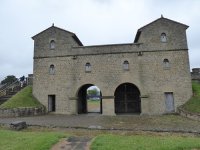The Roman Fort Gatehouse located near Tower Bridge in London is a fascinating architectural remnant that offers valuable insights into the city's ancient past. While much of the original fort has been lost to time, the gatehouse's remains provide a glimpse into the defensive strategies employed by the Romans and their architectural prowess.
The gatehouse, believed to have been constructed in the 2nd century AD, was part of the fortifications built by the Romans to protect the strategic port city of Londinium. As one of the primary entry points to the fort, the gatehouse played a crucial role in controlling access and ensuring the security of the Roman settlement.
The remains of the gatehouse include two bastions, which were fortified towers that flanked the entrance passage. These towers, built with sturdy stone and mortar, would have provided a commanding view of the surrounding area, allowing Roman soldiers to monitor and defend the entrance effectively. The surviving fragments of the bastions showcase the intricate masonry and architectural techniques employed by the Romans, attesting to their engineering expertise.
The gatehouse also featured a central passage, which would have been equipped with gates and other defensive mechanisms. While the original gates no longer exist, their design and operation can be inferred from similar Roman gatehouses found elsewhere. The gatehouse would have served as a highly fortified checkpoint, with Roman guards stationed to control and inspect individuals entering or leaving the fort.
The architecture of the Roman Fort Gatehouse near Tower Bridge reflects the Romans' emphasis on both functionality and aesthetics. The structures were built to withstand attacks and provide a sense of security, but they were also designed with an eye for grandeur and imposing presence. The use of stone for construction, the meticulous masonry work, and the incorporation of decorative elements all contribute to the gatehouse's visual impact.
The gatehouse's location near Tower Bridge is significant, as it underscores the strategic importance of the area. Situated near the River Thames, the gatehouse would have controlled access to and from the river, ensuring that the Romans maintained control over the vital waterway. It also demonstrates how the Romans integrated their military infrastructure with key transportation routes, further enhancing their ability to defend and govern the city.
Today, the remains of the Roman Fort Gatehouse can be observed within the grounds of a public park, close to Tower Bridge. While the surviving fragments provide only a glimpse into the original structure, they serve as a tangible reminder of the city's Roman past. Visitors can explore the site and imagine the bustling activity that once took place there, with soldiers patrolling the fortifications and travelers passing through the gatehouse.
The Roman Fort Gatehouse near Tower Bridge is a testament to the enduring legacy of Roman architecture and engineering. Its remains offer a window into the defensive strategies and military infrastructure employed by the Romans in London. By studying and appreciating these ancient structures, we can gain a deeper understanding of the city's rich history and the influence of Roman civilization on its development.
